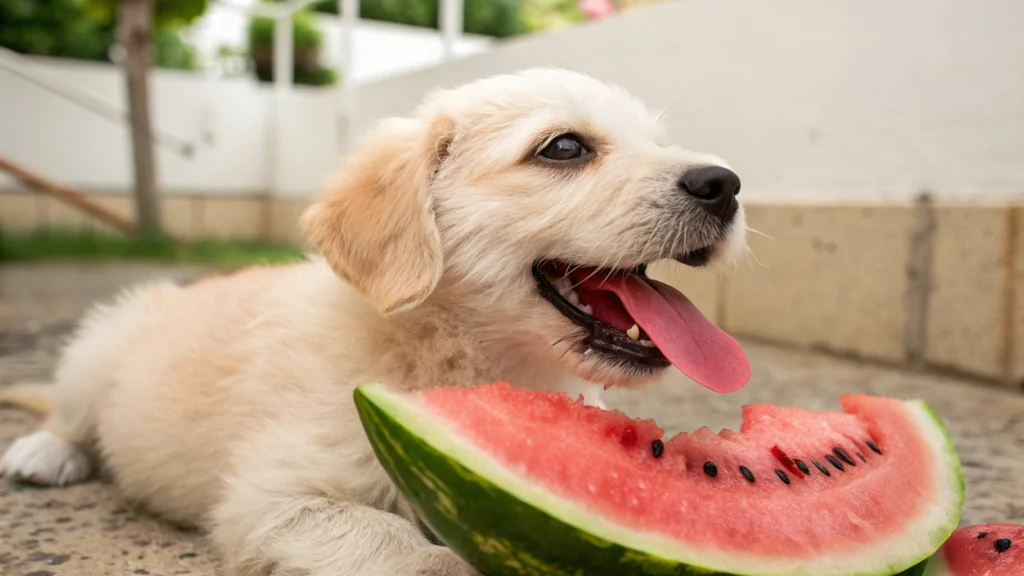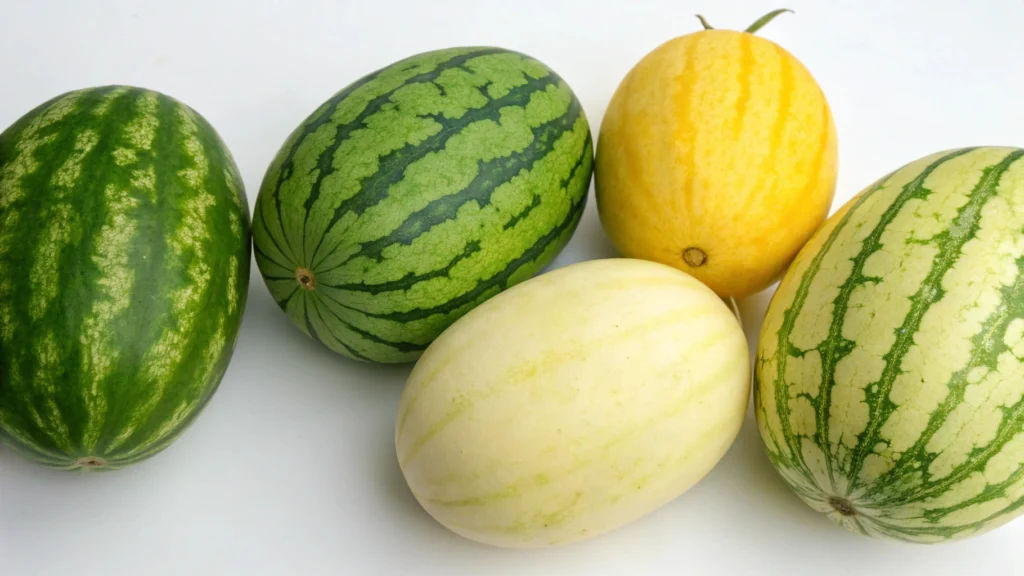“Can dogs eat watermelon?” is a common question among pet parents, especially during hot summer months. As your furry friend gazes at your juicy watermelon slice, you might wonder about sharing this refreshing fruit. The good news is that watermelon makes a wonderful treat for dogs when served properly! Whether you have traditional red watermelon or unique yellow-fleshed varieties, you can safely share this nutritious fruit with your canine companion. Watermelons are packed with vitamins A and C, potassium, and fiber, making them a healthy alternative to processed treats. Before sharing, though, it’s essential to know the proper serving method and which parts to avoid. Let’s discover how to make watermelon a safe and enjoyable treat for your dog!
DID YOU KNOW that yellow Watermelon existes ! check out : What is Yellow WaterMelon: A Complete Guide to This Sweet Fruit
Can Dogs Eat Watermelon? A Complete Safety Guide
Understanding Watermelon Safety for Dogs
Health Benefits and Nutritional Value

Let’s talk about whether can dogs eat watermelon and what makes it such a fantastic treat! Your furry friend can absolutely enjoy this refreshing fruit, packed with amazing nutrients. First, watermelon is super hydrating, containing about 92% water – perfect for those hot summer days! It’s also loaded with vitamins A and C, which help keep your pup’s immune system strong. Plus, this juicy treat contains potassium and fiber, making it great for digestive health. Whether you choose traditional red watermelon or try the unique yellow-fleshed varieties, your dog can benefit from these nutrients. The natural sugars in watermelon are much healthier than processed treats, and the low calorie content makes it an excellent choice for weight-conscious pups. Remember, you’re not just giving them a tasty snack – you’re providing a healthy, hydrating treat!
Potential Risks and Precautions
While watermelon is generally safe for dogs, there are some important things to watch out for. First, never feed your dog the rind or seeds, as these can cause tummy troubles or even become choking hazards. This applies to all varieties, from traditional green watermelon to yellow-meat watermelon types. Next, portion control is key – too much of any good thing isn’t great! Some dogs might get an upset stomach if they eat too much at once. Also, make sure to cut the fruit into small, manageable pieces to prevent choking. If you’re trying different types of watermelon, like purple or yellow varieties, introduce them slowly to see how your pup reacts. Watch for any signs of allergic reactions, though these are rare. Remember to always supervise your furry friend while they enjoy this refreshing treat!
Different Types of Watermelon Safe for Canines

Comparing Red, Yellow, and Purple Varieties
Did you know there’s more to watermelon than just the classic red variety? It’s super exciting to explore different watermelon colors with your furry friend! From the traditional red to the unique yellow watermelon and even rare purple varieties, each type brings its own special flavor. The yellow-meat watermelon, also known as yellow watermelon, has a honey-like sweetness that many dogs love. Then there’s the original watermelon with its classic pink-red flesh that we all know and love. Some dogs even prefer the slightly different taste of yellow-fleshed melons! Each variety is safe for your pup to enjoy, as long as you follow the same preparation guidelines. Just remember that whether you’re serving red, yellow, or purple watermelon, remove all seeds and rind first!
Natural vs. Seedless Watermelon Options
When choosing between natural and seedless watermelon varieties for your pup, both options can be great! Natural watermelons, including yellow watermelon varieties, come with seeds that you’ll need to remove carefully. Think of it as a little treasure hunt – you’re making the treat safe while discovering all the sweet, juicy bits! Seedless varieties, whether they’re traditional red or yellow color watermelon, make preparation much easier. Both types are packed with the same healthy nutrients your dog needs. From watermelon patches to grocery stores, you can find different kinds of watermelon year-round. The yellow watermelon benefits are similar to red ones – they’re all hydrating and nutritious! Just remember, even with seedless varieties, always check for and remove any white seeds that might be present.
How to Properly Serve Watermelon to Your Dog
Safe Preparation and Portion Guidelines
Let’s get into the fun part of preparing watermelon for your furry friend! First, can dogs eat watermelon safely? Absolutely, with the right preparation! Start by washing the outside of any variety, whether it’s traditional green watermelon or yellow-meated watermelon. Next, cut it into manageable chunks, removing all seeds and rind completely. For smaller dogs, dice the flesh into bite-sized pieces to prevent choking. A good rule of thumb is keeping portions to about 10% of their daily treats. When trying yellow watermelon or other varieties, start with small amounts to see how your pup reacts. Remember to remove those pesky yellow watermelon seeds too – they’re just as important to take out as regular ones! Keep the chunks fresh in an airtight container in the fridge.
Creative Serving Ideas for Hot Days
Time to make watermelon extra fun for your four-legged friend! Start by freezing small chunks of different types of watermelon – both red and yellow varieties work great for this. You can create exciting “pupsicles” by blending watermelon pieces and freezing them in ice cube trays. Some pups love their watermelon mixed with other dog-safe fruits for a colorful fruit salad. Try combining pieces of yellow-meat watermelon with regular red watermelon for a visually appealing treat! You can even use a melon baller to make perfect little spheres that are easy for your dog to eat. On super hot days, try freezing watermelon balls for a refreshing, icy treat. These creative serving ideas make answering “can dogs eat watermelon” even more fun!
Signs Your Dog Enjoys Watermelon Too Much
Monitoring Consumption and Digestive Health
When introducing watermelon to your dog’s diet, it’s important to watch for signs of enjoyment and potential overindulgence. Can dogs eat watermelon safely in larger amounts? Well, moderation is key! Watch for tail wagging and excited behavior – these are good signs. However, if your pup is gobbling down yellow watermelon or traditional red varieties too quickly, slow them down. Keep an eye on their bathroom habits after trying different types of watermelon. Some dogs might experience softer stools initially, which is normal with any new food. If you’re offering yellow-meat watermelon or other varieties, introduce them gradually. Monitor their reaction to ensure they’re digesting it well. Remember, every dog is different, so what works for one might not work for another!
When to Contact Your Veterinarian
Sometimes our furry friends can get a bit too excited about watermelon treats! While wondering “can dogs eat watermelon” safely, it’s important to know when to seek help. Watch for signs of tummy trouble, like excessive drooling or lethargy after eating any variety, whether it’s yellow watermelon or traditional red. If your dog shows signs of choking or gagging, especially with yellow watermelon seeds or rind pieces, contact your vet immediately. Diarrhea or vomiting after eating watermelon might indicate sensitivity. Also, if your pup develops any unusual behaviors after trying different watermelon colors or types, don’t hesitate to get professional advice. Remember, it’s always better to be safe and check with your vet if you’re unsure!
Seasonal Guide to Fresh Watermelon Selection
Identifying Ripe and Sweet Melons
Wondering how to pick the perfect watermelon when your dog asks “Can dogs eat watermelon?” Well, let’s make it fun! Look for melons that feel heavy for their size – that means they’re juicy! Whether you’re choosing yellow-meat watermelon or traditional varieties, check for a yellow spot on the bottom where it sat in the watermelon patch. Give it a gentle tap – a ripe melon should have a hollow sound. For yellow watermelon varieties, the outer rind might look similar to regular ones, but the flesh inside will be a beautiful honey color. Want to try purple watermelon? Look for the same signs of ripeness. The watermelon background color should be creamy rather than bright white. These tips work for all kinds of watermelon, ensuring your pup gets the tastiest treat!
Storage Tips for Maximum Freshness
Keeping your watermelon fresh is super important for those “can dogs eat watermelon” moments! Whether you’ve got yellow watermelon or traditional red varieties, proper storage is key. First, store whole melons in a cool spot around 55°F until you’re ready to cut them. Once cut, wrap the pieces tightly in plastic wrap or store them in airtight containers. Different types of watermelon, including yellow-colored watermelon, stay fresh for about 3-5 days in the fridge. For yellow-meat watermelon and other varieties, avoid storing cut pieces at room temperature. If you’ve got watermelon from your local patch, they might last a bit longer since they’re super fresh! Remember to check for any signs of spoilage before serving to your furry friend.
Frequently Asked Questions (FAQs)
Can Dogs Eat Watermelon?
Yes, dogs can safely eat watermelon! It’s a healthy, hydrating treat when served properly. Just remember to remove the seeds and rind first. Cut the flesh into bite-sized pieces to prevent choking. Whether you choose red or yellow watermelon varieties, your pup can enjoy this refreshing snack in moderation.
Is Watermelon Safe for All Dogs?
Most dogs can enjoy watermelon safely, but start with small amounts. Watch for any allergic reactions or tummy troubles. If your dog has diabetes or weight issues, talk to your vet first. This tasty treat works well for most pups when you follow the proper serving guidelines.
How Should I Prepare Watermelon for My Dog?
First, wash the watermelon thoroughly. Then remove all seeds and the rind completely. Cut the flesh into small, manageable pieces. For smaller dogs, make the chunks even tinier. Store unused pieces in an airtight container in the fridge. Always supervise your pup while they enjoy this treat.
What Parts of Watermelon are Dangerous for Dogs?
Never give your dog watermelon rinds or seeds. These can cause choking or digestive problems. The white part near the rind should also be removed. Stick to the juicy flesh only, whether it’s from red, yellow, or other watermelon varieties.
How Often Can Dogs Have Watermelon?
Treat watermelon as a special snack, not a regular meal. Give it 2-3 times per week maximum. One serving could be 2-3 small cubes for little dogs or up to a half cup for larger breeds. Remember, treats should only make up 10% of your dog’s daily food intake.
What Are the Benefits of Watermelon for Dogs?
Watermelon offers great health benefits for dogs! It’s packed with vitamins A and C, plus potassium. The high water content helps keep your pup hydrated. Plus, it’s low in calories and natural sugars, making it healthier than processed treats.
Making Watermelon a Safe and Healthy Treat for Your Pup
Now you know the answer to “can dogs eat watermelon?” it’s a yes, with some precautions! This refreshing treat, whether it’s traditional red or yellow watermelon, can become your pup’s favorite snack. Remember to remove those seeds and rinds, and cut the juicy flesh into perfect bite-sized pieces. Start with small portions to see how your furry friend reacts, then adjust the serving size based on their enthusiasm and tummy tolerance. Keep an eye out for the different varieties available in your local watermelon patch or grocery store – your dog might discover a new favorite! Always store unused portions properly to maintain freshness, and don’t forget to make it fun with creative serving ideas like frozen treats. Most importantly, enjoy watching your four-legged friend savor this healthy, hydrating snack. With these guidelines in mind, you’re all set to make watermelon a safe and enjoyable part of your dog’s treat rotation!
